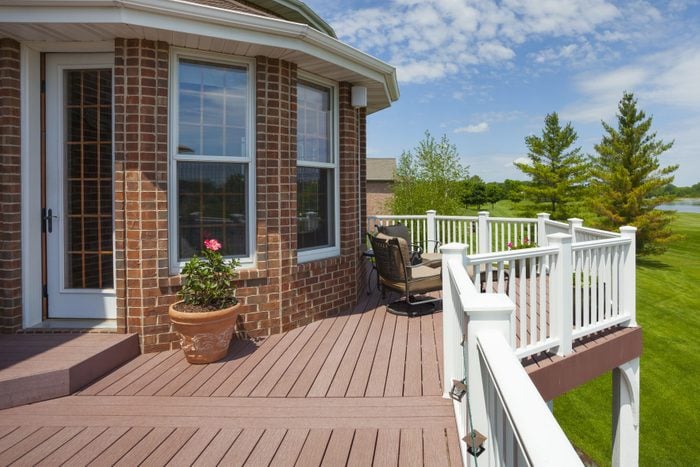Can You Paint Trex Decking?

Yes, you can and here's how. But should you paint Trex decking? Yes and no.
Our editors and experts handpick every product we feature. We may earn a commission from your purchases.
Composite decks involve less maintenance than wood but are more expensive, which is why “treated wood is still king in decking,” says Jase DeBoer, senior manager for Deckorators in Prairie du Chien, Wisconsin. “The market is about 70 percent wood and 30 percent composites.”
Still, composites have come on strong since Trex entered the deck market in 1996. When my son and I put a deck on his place a few years ago, there was no doubt we were going to build with composite, because of the low-maintenance. Lower-cost wood is still the top seller among homeowners in all income levels, but composite decks can dominate with homeowners in upper income levels. For example, in the wealthier western suburbs of Minneapolis, “composites sell way more than wood here in our store,” says Charlie Phillips, city desk sales person at Scherer Bros. Lumberyard in Hopkins, Minnesota.
Among composite deck owners, a common question is: Can you paint Trex and other composite decking? First, a little background.
On This Page
What is Trex/Composite Decking?
Composite decking is a mixture of wood fiber, plastic and a binding agent that is denser, stronger and heavier than wood. Trex is one brand of composite decking, and there are others, including Timbertech,and Deckorators. Composite decking is low-maintenance and has a long warranty. It’s also eco-friendly, because it’s made of reclaimed wood and recycled plastic. Trex claims, “The average 500-square-foot composite Trex deck contains 140,000 recycled plastic bags! That makes us one of the largest plastic bag recyclers in the U.S.”
Can You Paint or Stain Trex Decking?
Check with the manufacturer of your deck material, but with Trex the answer is yes and no.
Yes
You can paint or stain early-generation Trex styles (Origins, Accents, Profiles, Brasilia and Contours), which were not stain-, scratch- or mold-free and were subject to color fading with natural weathering.
A Trex painting bulletin says: “Yes, you can paint or stain early generation decking or railing to achieve a custom color, but it is not necessary for protection. Paints and stains that adhere well to wood will work as well or better with early generation products. Early generation decking and railing that has been faded (approximately 12 to 16 weeks for new product) can be painted or stained at any time, even years after it has been installed. Use a paint or stain that is designed for a walking surface. Contact the manufacturing to make sure these meet ADA (Americans with Disabilities Act) requirements for walking surfaces before applying.”
No
Trex introduced a high-performance composite decking product in 2010, and as of 2014, Trex no longer manufactures the early-generation composite decking. This newer decking should not be painted or stained. Today’s Trex composite decking has a shell that wraps around three sides of the board to protect it from the elements, provide resistance to fading, staining, scratching and mold. Thus, painting this shell would affect the shell’s performance and the 25-year limited residential fade and stain warranty.
The Trex painting bulletin says this about painting or staining the new decking: “The TOP SURFACE of Trex Transcend, Trex Enhance, and Trex Select decking CANNOT be painted or stained. However, painting the ends or underside of these deck boards is allowed. Exterior grade paints and stains that adhere well to wood will work on these surfaces. Use care to not allow paint or stain to get onto top surface of decking.”
DeBoer is against painting the ends or underside of composite deck boards. “Painting seals moisture into the wood-plastic material, which can cause rotting and cracking,” he says.
How To Paint or Stain Trex
If you want to paint early-generation Trex, here’s what to do:
- Clean the deck with a commercial deck cleaner or use a homemade mixture of soap and water. For mildew and molds on your deck, add vinegar and baking soda to the cleaning solution. Or, soak the surface with vinegar before washing with soap and water. Make sure to cover nearby plants to protect them from residue from cleaning, primer, paint or stains. Also, use painter’s tape to cover house siding at deck level.
- Use 240-grit sandpaper to rough up the boards to improve paint or stain adhesion.After sanding, wipe away the sanding dust with a tack cloth and then a damp rag. Let it dry before painting or staining.
- To help paint stick better to the deck surface, prime the boards using a sprayer, roller or brush and an acrylic latex primer designed for exterior applications only.
- Paint using a sprayer, roller or brush and a latex paint with a semi-gloss or satin finish. If you want to stain instead, use an acrylic latex stain with mildew and UV inhibitors.
Think Twice Before Painting or Staining
A case can be made for painting or staining composite decking that is no longer under warranty and that you want to make last a few more years. “But that’s a temporary fix to the inevitable solution of replacing the decking material,” says DeBoer.
“Don’t be penny wise and pound foolish,” says Phillips. “Replace your old boards with a new composite. You’ll have a new deck made of better material, and warranties get better with better products. The whole idea is to go maintenance-free with composites, so why paint it?”
The cost of composites has gone down with time. “The efficiency with the machining process has improved,” DeBoer says. “It’s easier than ever to get into composites with a product like Deckorators’ Trailhead, which is closing the price gap compared with wood. Wood is $1 to $2 a foot, and Trailhead is around $2 to $3 a foot. So, for an investment that is a bit more than wood, you get a new composite deck and a 25-year warranty.”



